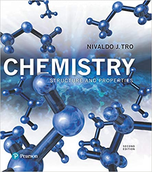?Sulfide \(\left(\mathrm{S}^{2-}\right)\) salts are notoriously insoluble in aqueous
Chapter 22, Problem 73(choose chapter or problem)
Sulfide \(\left(\mathrm{S}^{2-}\right)\) salts are notoriously insoluble in aqueous solution.
a. Calculate the molar solubility of nickel(II) sulfide in water. \(K_{\mathrm{sp}}(\mathrm{NiS})=3 \times 10^{-16}\)
b. Nickel(II) ions form a complex ion in the presence of ammonia with a formation constant \(\left(K_{f}\right)\) of \(2.0 \times 10^{8}\): \(\mathrm{Ni}^{2+}+6 \mathrm{NH}_{3} \rightleftharpoons\left[\mathrm{Ni}\left(\mathrm{NH}_{3}\right)_{6}\right]^{2+}\). Calculate the molar solubility of NiS in \(3.0 \ \mathrm{M} \ \mathrm{NH}_{3}\).
c. Explain any differences between the answers to parts a and b.
Text Transcription:
(S^2-)
K_sp(NiS) = 3 x 10^-16
(K_f)
2.0 x 10^8
Ni^2+ + 6 NH_3 rightleftharpoons [Ni(NH_3)_6]^2+
3.0 M NH_3
Unfortunately, we don't have that question answered yet. But you can get it answered in just 5 hours by Logging in or Becoming a subscriber.
Becoming a subscriber
Or look for another answer
